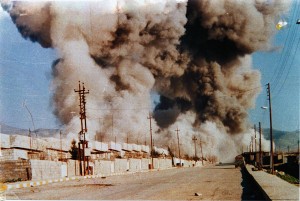By Eric Bruneau:
Khieli Hama is a Kurdish village on the Iranian border, close to Halabja, the Kurd’s martyr city where, on 16th March 1988, Saddam Hussein unleashed a chemical air attack killing 5000 people. In October 2013 the villagers of Khieli Hama tried to move bodies from a mass grave containing casualties of the 1980-1988 Iran-Iraq war. While doing so, an accident occurred. “Several people were contaminated”, explained a therapist from the Halabja anti-torture centre, a Bundesrepublik-funded dispensary treating victims of the 1988 chemical strike. The dead soldiers in the grave had been killed by combat gas and, when their corpses were unearthed, remnants of the toxin escaped and injured some of the villagers. “Our mobile team went there, and was able to treat the casualties immediately. We were able to react very quickly.”
The incident demonstrated that it is not just the aftermath of a 26-year old gas attack that Halabja people are dealing with, but also an ongoing contamination. In January 2013, a BBC team went to Halabja and filmed about rodents who keep dying in the town’s cellars. At the Halabja anti-torture centre, staff members were certain: the toxins spread during Saddam Hussein’s 1988 attack continue to kill, and not pests. “We had two or three patients who died in 2013,” one says. “They were time-delayed, but direct victims of the initial attack. In the same period, we admitted four new cases. They are to be directed to Sulaimaniya, where there are better equipments. They needed a more aggressive treatment.”
Najir is a veterinarian doctor. He exposes another aspect of the contamination. “The poison gas penetrated the soil. But to what extent? We do not know, and nothing has been done to find out. The vegetables growing in Halabja and its vicinity are cultivated in places hit by chemicals. The pastures where we send our cattle are places which have been hit by chemicals. As a result, our food is possibly contaminated. In this case, what are the effects on the human body?”
Eric Bruneau worked as an analyst for an information TV station in Sulaimaniya during 2009/10, and he has since returned to Iraqi Kurdistan to write articles about Kurdish issues.
.jpg)



